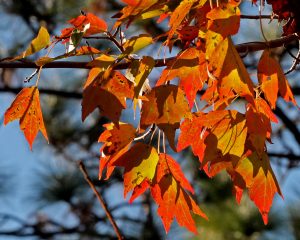Florida Red Maple, Acer rubrum

Photo by Peg Urban

Photo by Mary Keim
Height: 30-70 feet
Spread: 20-40 feet
LANDSCAPE USE
Excellent specimen tree, especially for moist sites. Beautiful in lawns and parks, particularly useful along moist highway and road shoulders and for providing cover around retention ponds, drainage swales, canal banks, and parking lots. Allow plenty of room for growth. Excellent fall color if you use Florida ecotype.
FORM
An erect, typically single-trunked tree, with a relatively narrow crown and ascending branches.
NATIVE RANGE
Swamps and floodplains. Southern Newfoundland, across southern Canada, southward throughout the eastern United States and Florida, into the Everglades, and west to Minnesota, Oklahoma, and Texas. Locally adapted stock performs better; plants from distant origins will likely give poor result.
CHARACTERISTICS
Flowers: Tiny, red, very showy, borne in profuse dusters before new leaf growth; male and female flowers produced on separate trees. Late winter to very early spring.
Leaves: Opposite, simple, palmately 3 to 5-lobed, medium green above, coated below with a dense covering of whitish hairs, variable in size, 2-inches long, 2-4 inches wide (individual trees may have leaves tending toward either of these extremes), margins toothed, and the leaf stalk and central leaf veins red. Exceptionally beautiful in fall with color ranging from soft yellow to reddish. Florida ecotype Red Maples will turn red multiple times depending on the weather.
Fruit: Red, 2-winged, V-shaped. I½-2½ inches long. Very showy. Spring.
Bark: Silvery gray; smooth when young, becoming roughened with age.
CULTURE
Soil: Prefers low, wet soils but will tolerate moist upland locations.
Exposure: Does best in dappled shade but will tolerate full sun. Young trees, especially, should be protected from strong sun.
Water: Prefers wet to moist conditions. Trees planted on drier sites will require supplemental irrigation.
Hardiness Zones: 3-10.
Life Span: Relatively short-lived; 50 to 80 years under cultivation.
BEST FEATURES including WILDLIFE SUPPORT
Grows fairly quickly and provides excellent color in winter, spring, and fall. Tiny red flowers appear in profusion as early as January, prior to emergence of new leaves, followed by conspicuous, bright red, winged samaras, or keys, which remain on the tree for several weeks and serve as an indicator of spring. Foliage sometimes turns red to yellowish in late fall, especially in the northern and north-central parts of the state. Can grow in either wet or moist upland soils. The smooth, silvery gray bark and handsome green leaves with red stalks and veins make it attractive year-round. Red Maple is a tremendous larval host for many butterflies and moths, making it in turn a critical food source for migrating birds.
COMPANION Plants
River Birch (Betula nigra), Bald Cypress (Taxodium distichum), Pipestem (Agarista populifolia), Loblolly Bay (Gordonia lasianthus), Dahoon Holly (Ilex cassine), Swamp Dogwood (Cornus foemina), Buttonbush (Cephalanthus occidentalis), Leather Fern (Acrostichum danaeifolium), Virginia Willow (Itea virginica), Wax Myrtle (Myrica cerifera), Climbing Aster (Symphyotrichum carolinianum).
DISADVANTAGES
Somewhat short-lived, subject to decay and disease if the bark or trunk is injured, intolerant of long periods of drought (especially if situated in well-drained uplands). Foliage and twigs may be damaged by leafhoppers and borers.
CULTIVARS Red maple has given rise to at least 57 cultivars that exhibit a variety of leaf sizes and fall color. None are regularly used in Florida landscaping with the exception of ‘Florida Flame.’ For best results, plants should be selected from Florida-grown stock, especially from the region in which the plant is to be used.
SIMILAR OR RELATED SPECIES
Four other maples occur in Florida: Box Elder (A. negundo), Silver Maple (A. saccharinum), Florida Sugar Maple (A. saccharum subsp. floridanum), and Chalk Maple (A. saccharum subsp. leucoderme). These four occur in Florida only in the northern half of the peninsula or in the central panhandle.
Florida’s Best Native Landscape Plants 200 Readily Available Species for Homeowners and Professionals, by Gil Nelson, 2003, University Press of Florida, page 8.